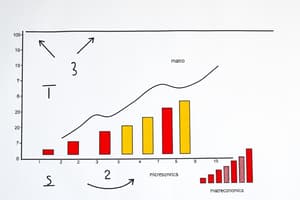Podcast
Questions and Answers
What does macroeconomics focus on?
What does macroeconomics focus on?
- Consumer spending
- Overall performance of the economy (correct)
- Market structures
- Individual economic choices
Which of the following is a key aspect of macroeconomics?
Which of the following is a key aspect of macroeconomics?
- Individual economic choices
- Net exports
- Market structures
- Fiscal Policy (correct)
What is aggregate demand in economics?
What is aggregate demand in economics?
- Total supply of goods and services in an economy
- Total demand for goods and services in an economy (correct)
- Total government expenditure
- Total number of firms in an industry
How does monetary policy influence the economy?
How does monetary policy influence the economy?
What is the purpose of fiscal policy in macroeconomics?
What is the purpose of fiscal policy in macroeconomics?
How does inflation affect an economy?
How does inflation affect an economy?
What does the unemployment rate measure in an economy?
What does the unemployment rate measure in an economy?
What do central banks monitor closely to avoid excessive fluctuations?
What do central banks monitor closely to avoid excessive fluctuations?
Flashcards are hidden until you start studying
Study Notes
Economics is an interdisciplinary field of study concerned with the production, distribution, exchange, and consumption of goods and services. It has two main branches: macroeconomics, which deals with the economy as a whole, including GDP (Gross Domestic Product), inflation, and unemployment rates; and microeconomics, which examines individual economic choices and market structures.
Macroeconomics
Macroeconomics focuses on the overall performance of the economy, analyzing trends and patterns over time. Key aspects of this branch include:
-
Aggregate Demand: This refers to the total demand for goods and services within an economy. Factors influencing aggregate demand include consumer spending, investment, government spending, and net exports.
-
Fiscal Policy: Government actions that influence aggregate demand through changes in taxes and public expenditure. For example, increasing government spending can stimulate growth during recessions.
-
Monetary Policy: Central banks set interest rates and control money supply to manage inflation, maintain stable prices, and promote full employment.
-
Inflation: A sustained increase in the general price level of goods and services over time. Central banks monitor it closely to avoid excessive fluctuations.
-
Unemployment Rate: Measures the percentage of unemployed individuals against the total labor force. High unemployment negatively impacts economic growth.
Microeconomics, on the other hand, focuses on individual households and firms. Its key concepts include:
-
Consumer Behavior: How consumers make purchasing decisions based on preferences, constraints, and information.
-
Production Functions: Represent how inputs like labor and capital produce outputs.
-
Market Structures: Determine how competition affects pricing and profitability across different industries.
-
Price Elasticity: Indicates how sensitive quantity demanded is to changes in product price.
In conclusion, both macroeconomics and microeconomics play vital roles in understanding the complexities of our economic systems. They help governments create policies aimed at stabilizing economies while encouraging sustainable growth and development.
Studying That Suits You
Use AI to generate personalized quizzes and flashcards to suit your learning preferences.




